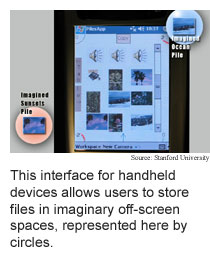
March
6, 2006
Piles
of PDA files
Despite the small screens of handheld devices we continue to try
to do more and more with the likes of cellphones and PDAs, from watching
television shows to running desktop applications. Researchers have been
trying to overcome the small screen limitation in recent years by using
imaginary space around the screens.
 A
pen-based technique
developed by Stanford University researchers lets users flick files into
virtual piles beyond the periphery of the screen. The piles, which are
independent of the underlying operating system file structure, organize
files and keep large numbers of files near at hand. Dragging a semicircle
at the edge of the screen to the center pulls the corresponding pile onto
the screen. The system allows users to maintain multiple workspaces, each
containing a set of piles.
A
pen-based technique
developed by Stanford University researchers lets users flick files into
virtual piles beyond the periphery of the screen. The piles, which are
independent of the underlying operating system file structure, organize
files and keep large numbers of files near at hand. Dragging a semicircle
at the edge of the screen to the center pulls the corresponding pile onto
the screen. The system allows users to maintain multiple workspaces, each
containing a set of piles.
Multiple users can share piles if their handheld devices have
wireless data links. One potential application is for teams of workers
collecting data in the field.
In the researchers' experiments users were able to manage as many
as ten piles at a time, and remembered the locations of their piles several
days after creating them.
(Piles Across Space: Breaking the Real-Estate Barrier on PDAs,
Computer-Human Interaction (CHI) 2006, April 22-28, Montréal, Canada)
Motion models how we meet
What does math have to do with friendship and sex? Quite a bit,
these days. Mathematical models are emerging as a useful tool for studying
and monitoring social networks.
Networks have three principal characteristics: a structure that
indicates the average degrees of separation between nodes, a clustering
coefficient that indicates the sizes and distribution of subgroups, and
a dynamical evolution that indicates the rate at which links and clusters
are formed and broken.
Scientists from the University of Stuttgart in Germany, Federal
University of Ceará in Brazil, and the Center for Theoretical and Computational
Physics in Portugal have developed a model
that captures all three characteristics using a single behavior -- motion.
The model contains mobile agents that move randomly and collide with each
other, with collisions representing acquaintanceships.
The researchers' model accurately represented the characteristics
of several networks: friendships among some 90,000 students at 84 schools
in the U.S, and sexual contacts among a network of 250 people.
The model could be used to map many types of networks, including
those that inform disease tracking and treatment, sociological studies,
and law enforcement.
(System of Mobile Agents to Model Social Networks, Physical
Review Letters, March 3, 2006)
Bits and pieces
Fingers do the browsing
A cell phone browsing
technique arranges information hierarchically in three-by-three grids
that correspond to the keypad, allowing users to navigate through each
layer with a single keystroke.
(FaThumb: A Facet-based Interface for Mobile Search, Computer-Human
Interaction (CHI) 2006, April 22-28, Montréal, Canada)
Commands hover, data touches
A pen-based
interface for handheld devices tracks command gestures made above
the screen. The software differentiates between in-air command gestures
and information written with the pen touching the screen.
(Hover Widgets: Using the Tracking State to Extend the Capabilities
of Pen-Operated Devices, Computer-Human Interaction (CHI) 2006, April
22-28, Montréal, Canada)
Cropping by eye
A gaze-tracking
system automates photo cropping by determining the important parts
of an image based on how the user looks at it. The technique could be
used for automatic snapshot editing, adaptive image displays and generating
thumbnails.
(Gaze-Based Interaction for Semi-Automatic Photo Cropping, Computer-Human
Interaction (CHI) 2006, April 22-28, Montréal, Canada)
Electric field refrigeration
An electric
field cools films of lead zirconium titanium oxide -- a phenomenon
dubbed giant electrocaloric effect. Like thermovoltaic materials, electrocaloric
materials could be used to cool computer chips and make motorless, gasless
refrigerators.
(Giant Electrocaloric Effect in Thin-Film PbZr0.95Ti0.05O3,
Science, March 3, 2006)
RSS Feeds: News Blog Books New: TRN's Internet Services TRN's Jobs Center News: Research News Roundup Research Watch blog Features: View from the High Ground Q&A How It Works Buy an ad link |
|
| Advertisements: |
|
Ad links: Clear History
Buy an ad link
|
TRN
Newswire and Headline Feeds for Web sites
|